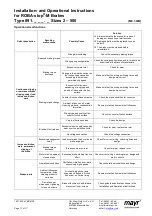
Installation- and Operational Instructions
for ROBA-stop
®
-M Brakes
Type 891. _ _ _ . _ Sizes 2 – 500
(B.8.1.GB)
16/11/2005 TK/KE/RJ
Chr. Mayr GmbH + Co. KG
Tel.: 08341 / 804-0
Eichenstraße 1
Fax: 08341 / 804-421
D-87665 Mauerstetten
http://www.mayr.de
Page 17 of 17
Germany
eMail:
Operational malfunctions
Defect description
Resulting
malfunctions
Possible Cause
Solution
Always dismantle the brakes for repair of
damage or inspection of malfunctions.
Damaged parts must be replaced to solve
defects.
The brake must be cleaned before
reinstallation..
Wrong dimensioning
Check the necessary braking torque
Reduced braking torque
Wrong spring configuration
Check the spring configuration, ask for brake to be
examined at the place of manufacture
Excessively worn rotor
Check for wear
Braking torque
decrease
Change in the wear behaviour on
the friction lining caused by
exceeding the maximum
permitted slip speed
Make sure that the wiring, switching times and
design are correct
Excessive friction work,
squeaking, wrong type and
quality of the counter friction
surface
Make sure that the wiring, switching times and
design are correct
Counter-friction surface corrosion
Check the brake condition for corrosion
Ambient influences, oil, water,
cleaning products, condensation
formation
Ensure protection from ambient influences
Wrong type and quality of the
counter friction surface
Check the counter friction surface
Braking torque change
Very low friction speeds
Check the design
Excessive tension path caused by
wear over the permitted limits
Check for wear, replace the rotor
Continuous slipping
or permanent brake
slipping under load,
increased friction
work
Brake will not release
No voltage connection
Check the voltage connection
Excessive engagement
times
Load accelerates the drive line as
brake engages
Check for correct wiring, switching times and
design
Braking torque
decrease
Excessive wear on rotor
Check for wear, replace rotor
Increased friction
work, permanent
slipping of
the brake.
Motor start-up against
closed brake
Excessive brake starting tractive
effort
Check correct wiring, switching times, design and
motor controls
Operational conditions
Oscillation, vibration, over-work,
excessively high speeds
Check operational conditions and design
Ambient influences,
temperature, fluids,
cleaning products,
corrosion
Friction lining sticks, jams,
expands. Variation in friction
behaviour on friction lining
Ensure protection from ambient influences
Broken parts
Deviations, set
dimensions, tightening
torque on screws
Brake attachment, hand release,
movement lever, screws
Check guidelines and values shown in the
Installation and Operational Instructions















